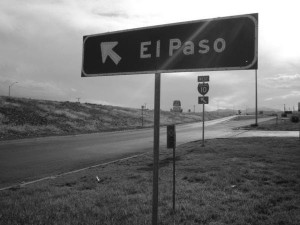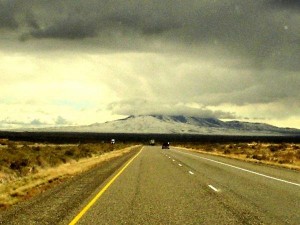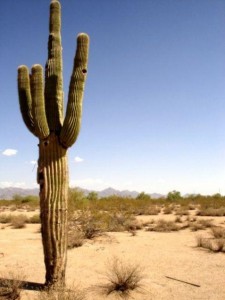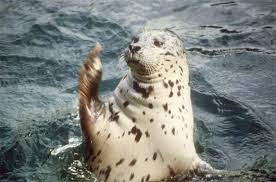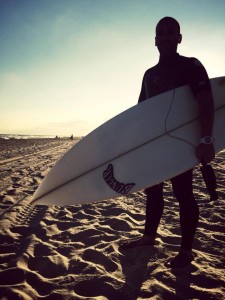Several years ago, I found myself sitting in the back of a Dodge conversion van on hour four of the eight-hour drive from San Antonio to El Paso. It was about 2:30 in the morning and everything outside the window was pitch black. You see, being from New York, I’m not used to these vast expanses of highway with completely nothing: no lights, no buildings, not even many other cars passing by in the opposite lane…just darkness. Suddenly, among the bright stars of the west Texas night, something caught my eye…a fire in the distance.
It looked so lonely just burning out there on the plateau. What was it? What was burning? It wasn’t a vast fire, but a small concise flame, like a torch. Then there was not just one fire, but dozens, scores. I remember being almost mesmerized by the long rows of flames jumping and dancing around in the night, like something out of a beautiful nightmare.
Then it occurred to me: we were driving through Texas oil fields. Suddenly these fires took on a new meaning of malevolence. These flames, which were the flares on the tops of oil wells, went on for miles and miles. I’ll never forget that feeling of suddenly realizing how mankind was basically stabbing the earth to death and draining its blood. That was the first time for me. The first time I really understood that something was really wrong. The strange part about it was how stunning those flames looked in the night…
This was my first time ever being in “The West.” I entered Texas driving along the Gulf Coast region from Louisiana with three of my buddies, where we had seen areas that were in complete disrepair from Hurricane Katrina. I began putting the pieces together in my mind. This was before I had ever really studied environmental issues and phenomena, but I knew there was some sort of relationship. It made perfect sense to me at the time that the Earth was sort of fighting back because we were stabbing it with all those oil wells and making it bleed.
Maybe I should take a step back about now and explain why I was in the middle of Texas in the first place. You see, I dropped out of college. Yes, I dropped out of college to pursue my dream of being a guitar player in a band and touring all over the country. So that’s exactly what I did. I was always sort of rebellious and did things my own way. I dropped out of Suffolk Community College because I had no idea what I was doing there or what I wanted out of an education. It felt like I was just spinning my wheels with no real direction. All I knew was that I wanted to hit the road. Sure, I told myself that one-day I would go back to school, but I had no idea when, or what for. All I was focused on was touring with my band. Little did I know was how playing guitar in a punk-rock band would become one of the most profound experiences of my life that would ultimately bring me to Stony Brook University as a Coastal Environmental Studies major.
So I pretty much lived in a van for a while and saw the entire lower forty-eight states. I was completely blown away by the vast expanses of the west. From the enchanting deserts and tall cacti of the southwest, to the snow-capped Cascade Mountains of Washington State. I had no idea how much absolute beauty and wonder there was out there. The thought of destroying these magnificent landscapes to drill for oil, or build pipelines, or build parking lots, absolutely appalled me. But what could I do to prevent further exploitation of these great landscapes? We were just a bunch of dirty, sweaty, twenty-somethings who basically left all we had back home to play music and see the country. Little did I know that everything I saw on that tour would build the foundation of my Environmentalism.
The following spring when back home in Long Island, I was out surfing at a semi-remote South Shore beach with some friends when I saw some strange splashing a few meters away from me. Of course the first thing that pops into your mind when you’re sitting on a surfboard in the ocean is “shark,” but luckily that was not the case. Staring at me from this relatively short distance was an adult Harbor Seal! He was actually really cute, sort of like a dog/cat face with long whiskers and big dark eyes. His head was about the same size as ours with gray and white speckles. Then a few seconds later, a second seal appeared! They were barking at each other playfully and just as curious about me as I was about them. They didn’t seem very afraid either. I’m sure they could tell that they were clearly better swimmers than me and had no reason to be afraid. But still, I had never seen seals in person before in all my years surfing on these beaches.
This was another pinnacle event in my development as an environmentalist. I began to question what had changed on these local beaches for there to be seals now and not before? I did a little research on my own and found that the ocean water quality had improved over the past decade via different legislation pertaining to what was allowed to run-off into our local waters. As the water quality improved, the small fish came back, which were followed by bigger fish, which in turn were followed by the seals. It was all making perfect sense to me at this point. Between my experiences on the road and now my up close and personal encounter with marine mammals, I had decided what exactly I wanted to return to school for: Environmental Science.
That night I went online and looked at the different programs offered at all the different local colleges and universities related to the environment. There was only one that really grabbed by attention: “Coastal Environmental Studies” at Stony Brook University. I emailed Dr. Michael Sperazza, the program’s director, to set up a meeting. We discussed the major and what I wanted out of my education and here I am today. My ultimate goal is to continue pursuing my passion for traveling by working in the fields of coastal zone management and sustainable infrastructure development throughout North America, South America and the Caribbean (I decided to minor in Spanish to help me with the latter).
It’s important that we all spend our time pursuing something that we are passionate about and makes us happy. For me, I am very content with the path that I have chosen. Although unconventional, it makes me who I am. It’s our experiences that help shape who we are, and in turn, help direct us towards a course of study. Then we can take our education and experiences together and unleash them upon the world to make a difference for real positive change. That, I would say, is the true essence of the Sustainability Studies program here at Stony Brook University.
By Justin Fehntrich
Sustainability Studies Program ’16
Coastal Environmental Studies Major
Spanish Language & Literature Minor


